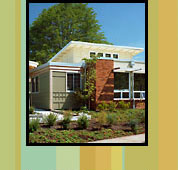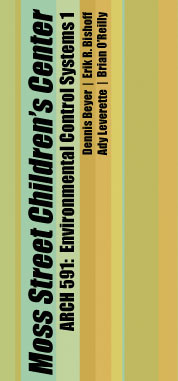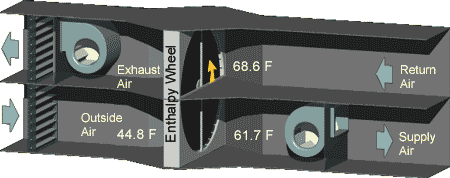

| Introduction | |
|
Based upon interviews with Dennis Reynolds, the building director, the occupants are generally pleased with the effectiveness of the passive and energy efficient thermal control strategies. However, he expressed concern that the heat recovery ventilator system was having an adverse effect on thermal comfort by introducing air that was significantly colder than room temperature. Accordingly, our research was focused on the heat recovery ventilator system to determine if it was performing at rated efficiency. There are two units operating in the building; we chose to study the south mezzanine unit.
Indoor air quality standards require that outside air be brought into the building year-round. This creates a necessary increase in a building’s heating or cooling load. Since our study took place in the winter, our focus was on heating load. The heat recovery unit is designed to reduce this increase in heating load. By passing return air in close proximity to incoming outdoor air through an enthalpy wheel, the heat recovery unit partially compensates for the difference in temperature and relative humidity between indoor air and outdoor air. By measuring temperature and relative humidity at four data collection points over a period of several days we were able to determine the enthalpy efficiency of the heat recovery unit. We found that it was performing well below rated efficiency. We brought to this to the attention of Facility Services, who determined that the filters were extremely dirty. They cleaned the filters and we ran a subsequent data collection for two days; which, although flawed by HOBO malfunction, strongly suggests that the HRU is now operating near its rated efficiency of 80%. |
|
HOME | ABSTRACT | INTRODUCTION | HYPOTHESIS | METHODOLOGY | RESULTS | SUMMARY | REFERENCES"The Answer is Blowing in the Wind"A study of the Moss Street Childrens Center ARCH 591 Final Project University of Oregon For information please contact: Dennis Beyer [ dbeyer1(at)uoregon.edu ] Erik R. Bishoff [ ebishoff(at)uoregon.edu] Ady Leverette [ aleveret(at)uoregon.edu ] Brian O'Reilly [ boreilly(at)uoregon.edu] |
|
